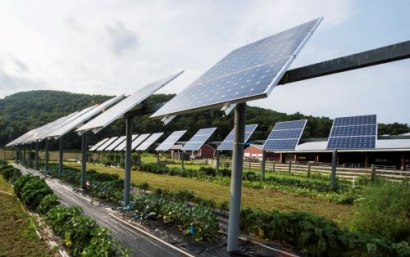
It finds commitments equivalent to 826 GW of new non-hydro renewable power capacity, at a likely cost of around $1 trillion, by 2030. (1GW is similar to the capacity of a nuclear reactor). Getting on track to limiting global temperature rise to under 2 degrees Celsius -- the main goal of the Paris Agreement -- would require the addition of around 3,000GW by 2030, the exact amount depending on the technology mix chosen. The planned investments also fall far below the $2.7 trillion committed to renewables during the last decade.
However, the report shows that the cost of installing renewable energy has hit new lows, meaning future investments will deliver far more capacity. Renewable energy capacity, excluding large hydro-electric dams of more than 50 MW, grew by 184 GW in 2019. This highest-ever annual addition was 20 GW, or 12%, more than the new capacity commissioned in 2018. Yet the dollar investment in 2019 was just 1% higher than the previous year, at $282.2 billion.
The all-in, or levelized, cost of electricity continues to fall for wind and solar, thanks to technology improvements, economies of scale and fierce competition in auctions. Costs for electricity from new solar photovoltaic plants in the second half of 2019 were 83% lower than a decade earlier.
"The chorus of voices calling on governments to use their COVID-19 recovery packages to create sustainable economies is growing," said Inger Andersen, executive director of UNEP. "This research shows that renewable energy is one of the smartest, most cost-effective investments they can make in these packages."
"If governments take advantage of the ever-falling price tag of renewables to put clean energy at the heart of COVID-19 economic recovery, they can take a big step towards a healthy natural world, which is the best insurance policy against global pandemics," Andersen said.
Renewable energy has been eating away at fossil fuels' dominant share of electricity generation over the last decade. Nearly 78% of the net new GW of generating capacity added globally in 2019 was in wind, solar, biomass and waste, geothermal and small hydro. Investment in renewables, excluding large hydro, was more than three times that in new fossil fuel plants.
"Renewables such as wind and solar power already account for almost 80 per cent of newly built capacity for electricity generation," said Svenja Schulze, minister of the environment, nature conservation and nuclear safety, Germany. "Investors and markets are convinced of their reliability and competitiveness."
2019 marked many other records, the report finds:
The highest solar power capacity additions in one year, at 118 GW.
The highest investment in offshore wind in one year, at $29.9 billion, up 19% year-on-year.
The largest financing ever for a solar project, at $4.3 billion for Al Maktoum IV in the United Arab Emirates.
The highest volume of renewable energy corporate power purchase agreements, at 19.5GW worldwide.
The highest capacity awarded in renewable energy auctions, at 78.5GW worldwide.
The highest renewables investment ever in developing economies other than China and India, at $59.5 billion.
A broadening investment, with a record 21 countries and territories investing more than $2 billion in renewables.
The 2019 investment brought the share of renewables, excluding large hydro, in global generation to 13.4%, up from 12.4% in 2018 and 5.9% in 2009. This means that in 2019, renewable power plants prevented the emission of an estimated 2.1 gigatonnes of carbon dioxide, a substantial saving given global power sector emissions of approximately 13.5 gigatonnes in 2019.
"Clean energy finds itself at a crossroads in 2020," said Jon Moore, chief executive of BloombergNEF. "The last decade produced huge progress, but official targets for 2030 are far short of what is required to address climate change. When the current crisis eases, governments will need to strengthen their ambitions not just on renewable power, but also on the decarbonization of transport, buildings and industry."

